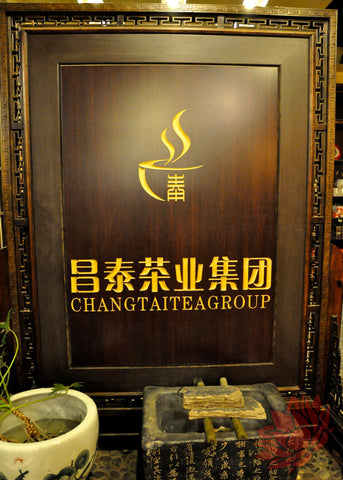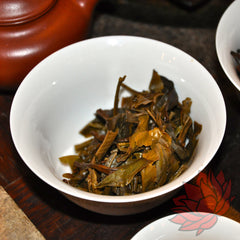Sampling Aged Puerh with Chang Tai February 24 2014

Improving with age is one of the abilities puerh possesses that separates it from other teas. The microbiological fungal fermentation taking place on the leaves is constantly altering the puerh. This is a slow process that can take decades. Aging puerh is something that is talked about at great length but not often witnessed first hand. The process can take great time and is very dependent on environment. If your puerh is stored in an environment that is too humid it can create mold. Conversely, if it is stored in an environment that is too dry it can kill the good bacteria that is working hard to improve the puerh. The middle road between these extremes is a wide one and there is much discussion on exactly where and how and for how long should puerh be aged. We were fortunate enough to have our friends at Chang Tai teach us first hand the differences possible with aging in different environments.

Chang Tai is a very well respected producer of quality puerh. They have a very nice shop in the Kunming Kangle Tea City Market. It's one of the larger shops and is furnished with some really amazing tea tables made of salvaged wood from old Chinese boats. Ms Chen Lu works here and is a wealth of puerh knowledge. When we discussed puerh aging she gave us the opportunity to sample tea from 2 identical cakes, each of which had been aged in different areas with different environments. The puerh she had for us was a 2006 sheng puerh from Nannuo Mountain (2006 ChangTai Nannuo Shan Cha Hu Chen Sheng Puerh). This puerh was Spring picked from wild trees over 100 years old. One cake was aged in Menghai, and the other was aged in Kunming.

Weather-wise Menghai and Kunming are about as similar as Miami is to Denver. Menghai is in Xishuangbanna at the southern edge of Yunnan. This area borders Laos, Myanmar, and Vietnam. It is hot and humid with seasonal fluctuations. Kunming is much higher in altitude and is cooler and dryer with more stability throughout the year. Hotter humid climates will age puerh faster. The heat and moisture provide the perfect environment for the bacteria in puerh to flourish. Puerh will age in dryer climates but it will do so at a slower pace.
I've read a lot about aging puerh, and I understand the principles, but I had yet to to witness the difference for myself. The differences in these identical cakes was striking. The first thing you notice is the aroma. The Kunming aged cake has a welcoming, sweet aroma that is very floral. It smells like the young sheng puerh that it is. The Menghai aged cake is drastically different! It has an aroma that is at first a tad unwelcome. The aroma introduces a musky attitude with shadows of mustiness. It's not quite earthy in the way a shou puerh would be earthy. It's completely opposite of the Kunming aged cake. It's quite amazing. These cakes have less than a decade of aging on them and already exhibit extreme differences.
The Kunming aged cake presents a flavor that is astringent, yet comfortable. It is in every way like a young sheng that is starting to grow up. The Menghai aged cake is well on its way to being fully fermented. The flavor is dark, musty, and earthy. Both are amazing to drink side by side. Being able to see, smell, and taste the differences is a real treat.


As we brew more the differences solidify. The Kunming aged cake keeps the astringency and brings in a sweet aftertaste. The Menghai aged cake keeps a dark color, aroma, and flavor. These two cakes are like twin children separated at birth with one raised in high society and the other on the wrong side of the tracks. I was continuously surprised at the differences.
I felt the energy in the Kunming aged cake come on from the beginning. The other cake held back until after the 4th brew. Then with an increasingly smooth and rich experience the energy presented itself. Ms Chen said that it would take 20 years of aging in Kunming for that cake to reach the stage that 7 years of aging in Menghai had done. That's pretty dramatic.

We kept drinking past 10 steeps. I lost count. Ms Chen is a fantastic fount of knowledge and we chatted for hours. She said that both cakes would be able to brew more than 20 times. After 10 steeps both still held their color. The leaves tell the tale of aging. The Kunming aged leaves are still bright green with redness creeping in from the edges. The Menghai aged leaves are dark and a deep amber bordering on black.


It's hard for me to tell which one was better at this stage. I really enjoyed both, but for my tastes I liked the Kunming aged cake more. It felt young, but with some experience. The Menghai aged cake felt rushed. I had thought the Menghai aged cake might have tasted more like a shou puerh, and while there were a few similarities it was a different thing entirely. Now I want to try these same cakes after 20 years of aging.
This is part of what really fascinates me about puerh. There are near infinite flavor and aroma opportunities. Here we saw two cakes that started off identical with the only dividing line created by temperature and humidity. Truly remarkable to witness. Hopefully I'll have more opportunities to investigate the effects of aging on puerh in the future. If only I had a time machine…
Much thanks to our Chang Tai host Ms Chen Lu who was gracious enough to offer her time, knowledge, and puerh to help us on our quest to learn.
All images © Crimson Lotus Tea 2014
